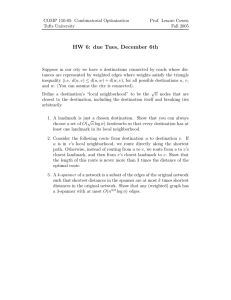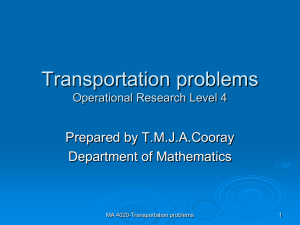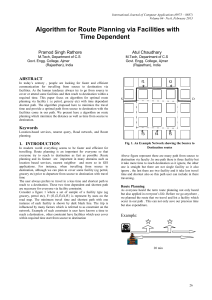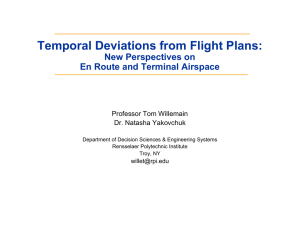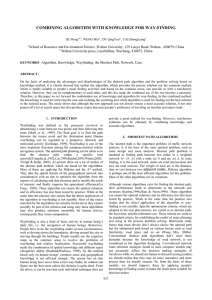Chapter 6
advertisement
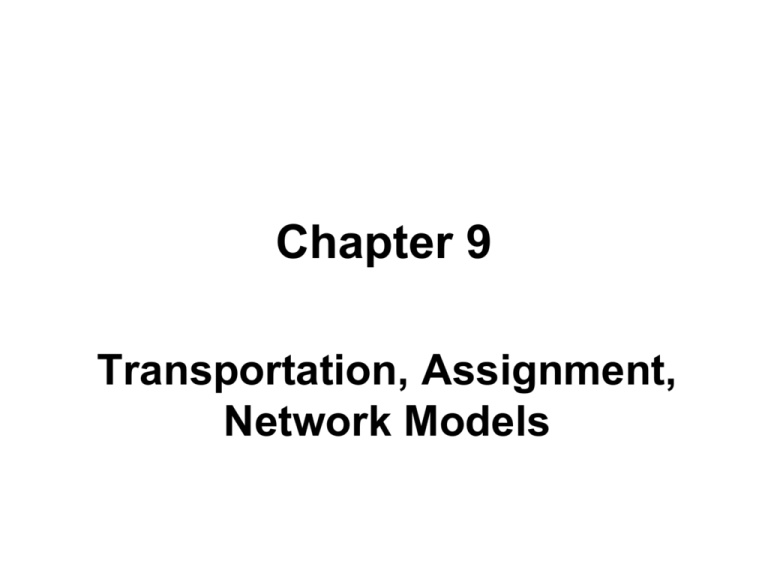
Chapter 9 Transportation, Assignment, Network Models A Transportation Example, p.325 Suppliers (Sources) Demanders (Destinations) Albuquerque Boston Cleveland Capacities of Suppliers Des Moines $5/unit $4/unit $3/unit 100 units Evansville $8/unit $4/unit $3/unit 300 units Fort Lauderdale $9/unit $7/unit $5/unit 300 units 300 units 200 units 200 units Demands of Demanders How to satisfy demands by using the sources with minimized total cost? (That is: How many units should be shipped from each source to each destination?) The Transportation Problem • To find the most economical way of allocating m sources to n destinations. • Given: – Capacity of each source; – Demand of each destination; – Transportation cost to ship one unit from a source to a destination. Solving Transportation Problem • The methods in textbook 9.5, and 9.6 are for doing by hand. – Do not worry about them. • Management users use computer software ‘QM for Windows’. (p.360-362) – We use this method! Unbalanced Transp. Problem • Where total supply ≠ total demand • Solve the problem same way as for the balanced transportation problem • Dummy source / dummy destination Prohibited Route • If a route is prohibited to use, just set the unit transportation cost of that route to a large number. Facility Location Analysis by Using Transportation Model • If a new facility (a plant or a warehouse for example) is to be added to an existing transportation system, then the transportation model can be used in decision making on the location of the new facility by evaluating the alternatives of the new facility location. Example p.327-328 • A new plant is to be added to an existing system (Table 9.1). • Two alternatives for the new plant: Seattle and Birmingham. • Unit shipping cost from plants to warehouses are in Table 9.2. Example (continued) • We need to run the transportation model twice to evaluate: – The total production/shipment cost if the new facility were placed in Seattle; – The total production/shipment cost if the new facility were placed in Birmingham. • Then, select the alternative with the lower total cost. The Assignment Problem • To assign m persons to m jobs. • Given – The cost (or efficiency index) for a person to do a job. An Example of Assignment Problem, p.330 Costs of doing projects Projects 2 Persons 1 3 Adams $ 11 $ 14 $ 6 Brown $ 8 $ 10 $ 11 Cooper $ 9 $ 12 $ 7 Solving Assignment Problem • It can be solved conveniently by using the ‘Assignment module’ in computer software “QM for Windows”. • It is a special transportation problem. An Example of Assignment Problem Driving distances (miles) for the officials Official (persons) Raleigh Game Sites (jobs) Atlanta Durham Clemson A 210 90 180 160 B 100 70 130 200 C 175 105 140 170 D 80 65 105 120 What Is a Network • A network is composed of nodes and arcs. Maximum Flow Problem • Given flow-capacities between nodes, find the maximum amount of flows from the origin node to the destination node. • Applications: Capacity of traffic flows between two points of a city. • Example: p.335 Shortest Route Problem • Given distances (costs) between nodes, find the shortest route between any pair of nodes. • Applications: Find the shortest route from one place to another. • Example: p.337 Minimum Spanning Tree Problem • Given costs (distances) between nodes, find a network (actually a “tree”) that covers all the nodes with minimum total cost. • Applications: Planning water pipe, power cable, or phone line to the residents in a community. • Example: p.338 What You Need to Know • For each of the five models: – What is the model? (what are given and what is to calculate) – What is the model for? (Applications) – Solve it by QM • You do not need to know the solution technique since QM does it for us. • But given an application, you should tell which model fit the application and solve it by QM.

